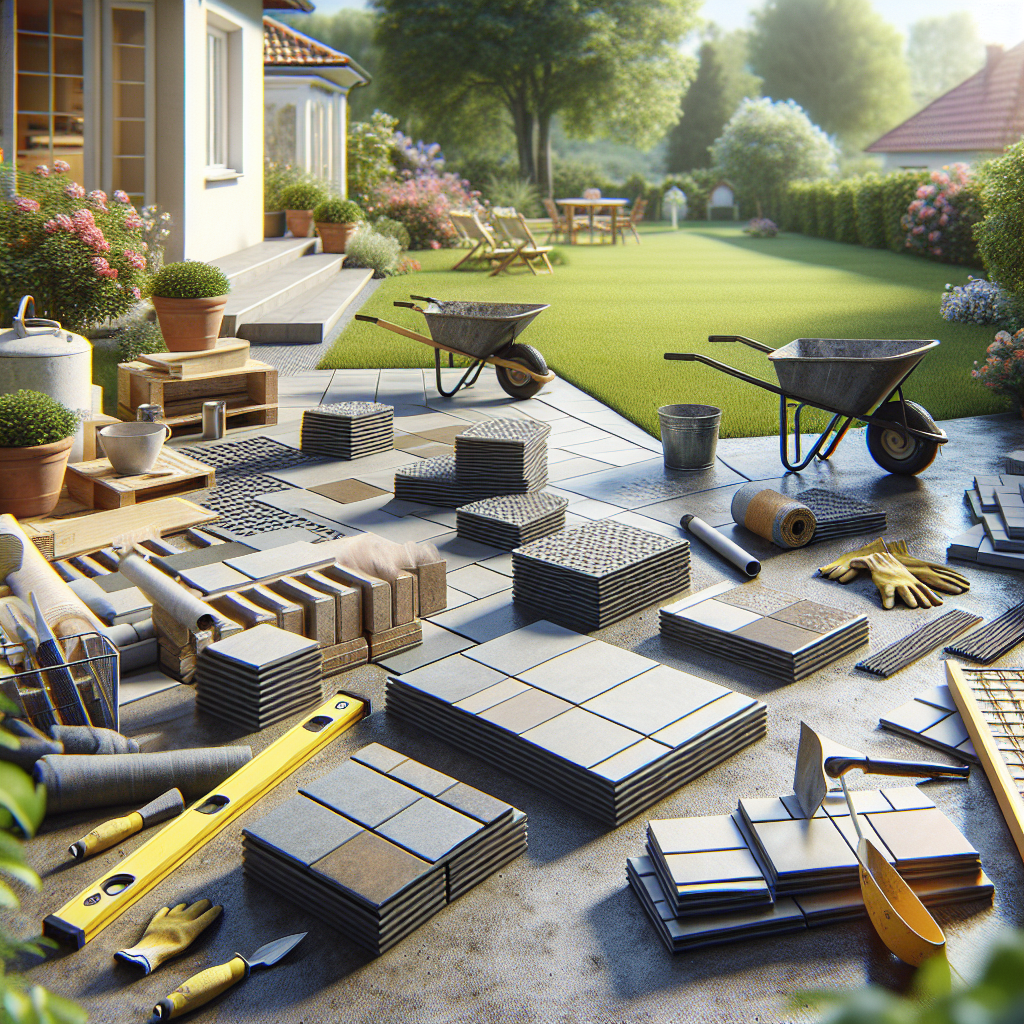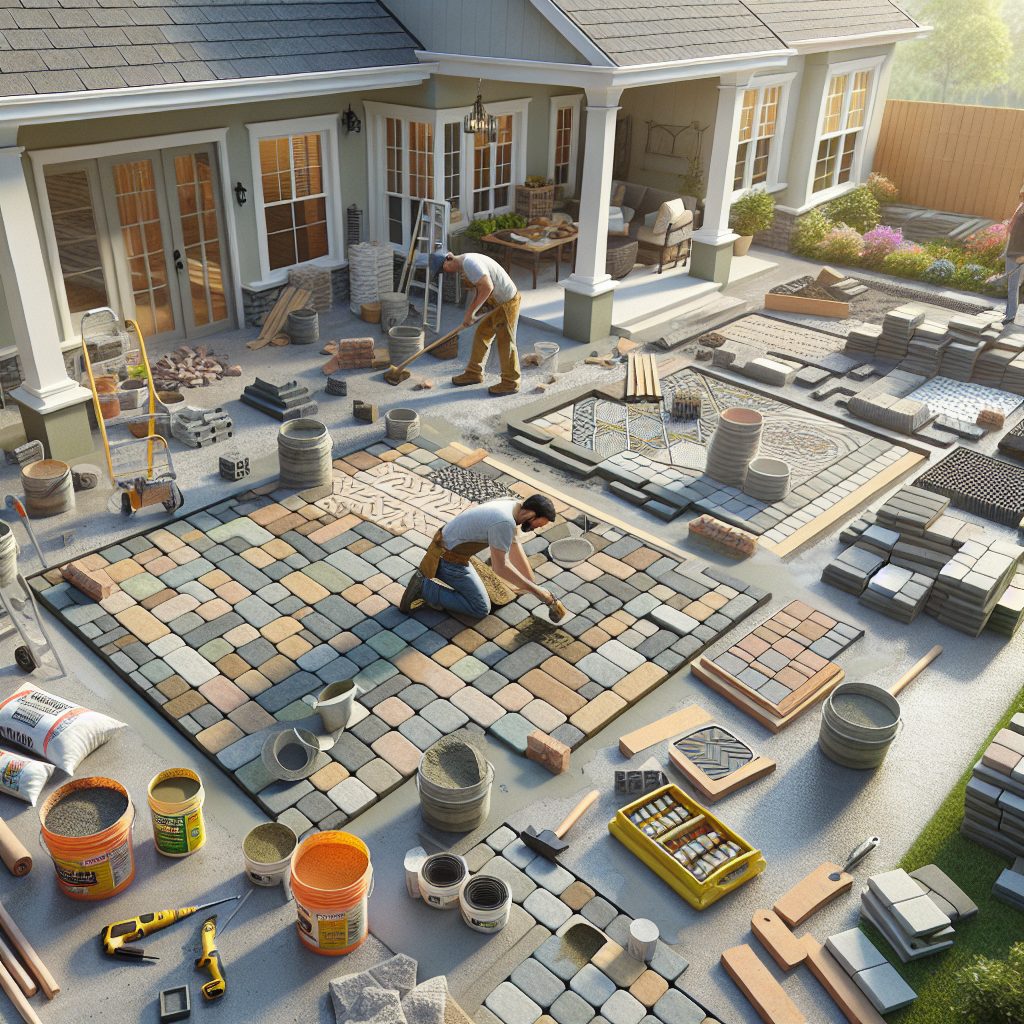Creating the perfect patio can transform your backyard into a serene outdoor living space, perfect for relaxation and entertaining guests. Whether you’re envisioning a cozy spot for morning coffees or a spacious area for family barbecues, understanding the essentials of patio installation is your first step towards a successful project. In this guide, we’ll explore key factors to consider when choosing a patio contractor and provide you with top questions to ask before making a hiring decision. Let’s dive into making your patio dreams a reality!
Understanding the Essentials of Patio Installation
Installing a patio involves more than just laying stones—it’s about creating a harmonious extension of your home that enhances your lifestyle. To begin, it’s crucial to consider the purpose of your patio, the materials that best suit your needs, and the overall design that complements your home’s architecture. From choosing the right materials like pavers, concrete, or natural stone, to understanding zoning laws and obtaining necessary permits, each step plays a pivotal role in the success of your project.
Key Factors to Consider When Choosing a Patio Contractor
Selecting the right contractor is vital for ensuring your patio is installed correctly and to your satisfaction. Consider the following:
- Experience: Look for a contractor with extensive experience in patio projects similar to yours.
- Reputation: Check reviews and ask for references to gauge the reliability and quality of their work.
- License and Insurance: Ensure they are fully licensed and insured to protect yourself against any liability.
Top Questions to Ask Before Hiring a Patio Installation Contractor
Before finalizing your decision, it’s essential to ask potential contractors several key questions:
- Can you provide a detailed written estimate?
- What is the expected timeline for completion?
- How do you handle unexpected issues or delays?
- Can you provide examples of past patio installations?
Armed with the right information and a reliable contractor, your patio installation project will be set for success, paving the way to many enjoyable moments outdoors.

If you’re ready to take your home improvement or construction project to the next level, we can help! Find trusted contractors on BuildNet, whether you’re looking for renovations, new builds, electrical work, plumbing, or anything in between. Our directory connects you with qualified professionals who can make your vision a reality.
Understanding the Essentials of Patio Installation
Welcome to the wonderful world of patios! Whether you’re looking to enhance your backyard for those summer BBQs or craft a cozy outdoor retreat, understanding the essentials of patio installation is your first step to creating that perfect outdoor space. Let’s dive into what makes a successful patio project.
Choosing the Right Materials
First things first, selecting the right materials is paramount. The variety of options can be overwhelming, but here’s a breakdown to help simplify your decision:
- Concrete: Affordable and versatile, concrete is a popular choice for patios. It can be stamped, engraved, or stained to enhance its appearance.
- Pavers: Available in a myriad of shapes, colors, and textures, pavers add an elegant touch to your patio and are relatively easy to replace if damaged.
- Stone: Nothing quite matches the natural beauty of stone. It’s durable and offers a unique look but can be pricier and requires more skilled installation.
- Brick: Brick patios offer a classic aesthetic and durability, though they can be more expensive and require significant upkeep to maintain their look over time.
- Tile: Ceramic or porcelain tiles can create a stunning patio surface but are best suited for mild climates as they can crack in freeze-thaw conditions.
When choosing materials, consider your climate, budget, and the style of your home to ensure your patio complements your existing architecture and landscape.
Understanding the Groundwork
The foundation of any great patio is in its base and groundwork. Proper excavation and preparation are crucial:
- Excavation: Depending on your chosen material, the depth of your excavation may vary. Typically, you’ll need to dig down several inches to accommodate the base material and ensure a level start.
- Base material: Gravel is commonly used as it ensures good drainage and stability. The depth and type of gravel should be chosen based on soil type and expected load on the patio.
- Compacting: This step is vital as it prevents the patio from settling unevenly later. A plate compactor is used to press down the base material.
- Laying sand: Before placing your pavers, bricks, or stones, a layer of sand is needed to help level out the surface and fill the joints after the pavers are placed.
Skipping any of these steps might lead to a patio that’s prone to cracks, uneven surfaces, or, worse, structural failures.
Design and Layout Considerations
Designing your patio should be both a fun and strategic undertaking. Here are a few considerations to keep in mind:
- Size and shape: Consider the size of your yard and the scale of your home. A large patio can overwhelm a small space, whereas a tiny patio in a vast open area might look out of place.
- Privacy: Depending on its use, your patio might need fencing or landscaping features to create a more private area.
- Sun and shade: Think about the positioning of your patio regarding the sun. If you enjoy sunbathing, a sunny spot is perfect, but if not, consider areas with natural shade or plan for a pergola or umbrella.
- Accessibility: Your patio should be easily accessible from your house. Consider paths or stepped access if level changes are involved.
Each element should be considered in harmony with the others to create a cohesive and functional space.
Permits and Regulations
Before any work begins, it’s important to understand the local building codes and regulations. Most localities require permits for construction that alters the footprint of your home. These regulations might influence the materials you can use, the dimensions of your patio, and its location relative to property lines.
Checking with your local building department or a knowledgeable contractor can save you a lot of hassle. They can provide guidance on what’s required and help ensure your project is up to code.
Maintenance and Upkeep
Once your patio is installed, keeping it looking its best involves regular maintenance:
- Cleaning: Regular cleaning will keep your patio free of stains, moss, and debris. The method will vary by material, but gentle soap and water typically do the trick.
- Sealing: Some materials, like pavers and certain types of stone, may require sealing to prevent staining and weather damage.
- Repair: Be vigilant about replacing cracked pavers or stones, and re-sanding joints as needed.
Maintenance not only increases the longevity of your patio but also maintains its beauty and functionality over time.
Starting a patio project is an exciting endeavor, and with the right planning and considerations, you can ensure that this addition will be one of the highlights of your home. By understanding the basics of patio installation—from choosing the right materials to laying down a solid foundation—you’re well on your way to creating an outdoor space that you and your family will enjoy for years to come.

Key Factors to Consider When Choosing a Patio Contractor
So, you’ve decided to enhance your outdoor living space with a new patio—congratulations! This addition is not only a boost in enjoyment but often increases the value of your home. But before you can start picking out furniture and planning your first outdoor gathering, you need to find the right contractor to bring your patio dreams to life. Let’s dive into some essential factors to consider when choosing a patio contractor that will ensure a smooth and successful project.
1. Experience and Expertise
First things first, you want a seasoned professional who knows their way around patio installations. Experience is a significant indicator of a contractor’s ability to handle your project. Look for companies that specialize in outdoor spaces and have a robust portfolio of completed patios. Not only does this give you peace of mind, but it also offers you a chance to gauge their expertise based on similar projects.
2. Licensing, Bonding, and Insurance
It might not be the most thrilling aspect to consider, but it’s crucial. Ensure your patio contractor is licensed, bonded, and insured. This protects you from liability in case of accidents and ensures the contractor meets the professional standards required by your local authorities. Don’t hesitate to ask for proof of insurance and check that their policy is active.
3. Local Reputation
When it comes to choosing a contractor, the local reputation can tell you a lot. A reputable contractor in your area is likely familiar with regional building codes and climate considerations. Check online reviews, ask for references, and maybe even chat with neighbors who’ve had similar work done. A strong local presence generally indicates a reliable track record and a higher level of accountability.
4. Detailed Quotes and Contracts
A professional patio contractor should provide a detailed quote that outlines all aspects of the project, from materials and labor costs to timelines and payment schedules. This quote should be part of a formal contract that protects both parties. Ensure everything is in writing and clearly stated, so there are no surprises once the work begins.
5. Communication Style
Never underestimate the importance of good communication. During your initial consultations, note how the contractor answers your questions. Are they patient and clear with their explanations? Do they offer constructive suggestions and seem enthusiastic about your project? You want someone who is not only responsive but also proactive in keeping you updated throughout the project.
6. Material and Design Options
The best patio contractors will offer a range of materials and designs. Whether you’re looking for a traditional brick layout, sophisticated stone, or modern concrete designs, having options means the contractor can tailor the project to suit your specific taste and budget. During consultations, ask to see samples or a portfolio of different materials and finishes they’ve worked with.
7. Warranty and Aftercare
A reliable contractor will stand behind their work with a warranty. This shows they are confident about the quality of their work and their commitment doesn’t end once the patio is installed. Additionally, check what kind of aftercare services they offer. This could include maintenance tips or periodic check-ups to ensure your patio remains in top shape.
8. Cost and Payment Terms
While cost should not be the sole deciding factor, it’s undoubtedly significant. Get several quotes to compare and understand what the market rate is in your area. However, beware of quotes that seem unusually low as they might reflect subpar materials or workmanship. Equally important are the payment terms; ensure they are reasonable, and there aren’t any hidden fees.
9. Timeframe for Completion
Last but not least, discuss the projected timeline. A good contractor will be able to provide a realistic timeframe for when your patio will be ready. Consider how this fits with your schedule and any upcoming events you might be planning. Delays can happen, but there should be a plan in place to handle them effectively.
Choosing the right contractor is pivotal to ensuring your patio project runs smoothly from start to finish. By keeping these factors in mind, you’ll be better equipped to make an informed decision that leads to a beautiful and well-constructed patio. So, take your time, do your homework, and soon, you’ll be enjoying your new outdoor space!
Top Questions to Ask Before Hiring a Patio Installation Contractor
So, you’ve decided to enhance your outdoor living space with a new patio—congratulations! A well-designed patio not only boosts the aesthetic appeal of your home but also increases its market value. However, the key to a successful patio installation lies in the hands of the contractor you choose. To ensure you team up with the right professional, there are specific questions you need to ask. Let’s walk through these questions to help you make an informed decision when hiring a patio installation contractor.
1. What Experience Do You Have with Patio Installations?
First things first, you want to know about the contractor’s experience. It’s not just about how long they have been in business, but specifically how much experience they have with patio installations. Ask for examples of recent projects, and if possible, references or reviews from past clients. This can give you a glimpse into their craftsmanship and the quality of their work.
2. Are You Licensed and Insured?
This is a crucial question. Ensure your contractor is licensed to perform construction work and carries the necessary insurance, including liability and workers’ compensation. This protects you from any potential liabilities in case of accidents or damages during the project. Ask for copies of their insurance certificates and check that they are up to date.
3. Can You Provide a Detailed Written Estimate?
Discussing finances upfront is essential. Ask for a detailed estimate that includes the cost of materials, labor, and any other expenses that might affect the overall cost of the patio installation. This will help you budget accordingly and avoid any hidden charges popping up midway through the project.
4. What Materials Do You Recommend and Why?
The durability and appearance of your patio largely depend on the materials used. A reliable contractor will suggest suitable materials based on your climate, the soil type in your area, and your aesthetic preferences. They should be able to explain the pros and cons of different materials, such as concrete, pavers, stone, or tiles.
5. What Is the Project Timeline?
Understanding the timeline of the project is important. Ask the contractor to provide a start date and an estimated completion date. Make sure they also explain how they handle unexpected delays due to weather or material shortages. This will help you plan your schedule around the project and set realistic expectations.
6. How Do You Handle Changes or Adjustments During the Project?
It’s not uncommon for project details to change once the work gets underway. Ask how the contractor handles changes in scope or design, including their process for quoting and approving extra costs. This can save you from disputes and additional charges later on.
7. What Kind of Warranty or Guarantee Do You Offer?
A warranty or guarantee reflects the confidence a contractor has in their workmanship. Ask about the type of warranty they offer on the materials and the installation. Ensure you get this in writing, so you have recourse in case there are issues with the patio after completion.
8. Will You Handle the Necessary Permits?
In many areas, installing a patio requires specific permits from the local authorities. A professional contractor should be familiar with the necessary permits and zoning laws in your area. Verify that they will handle all the paperwork and ensure the project complies with local regulations.
9. How Do You Manage Cleanup and Disposal After Completion?
The last thing you want after a patio installation is dealing with leftover materials or waste. Ask the contractor about their cleanup procedures and whether they include disposal services in their quote. This not only eases your workload but also ensures your property is neat and tidy, ready for you to enjoy your new patio.
10. Can You Provide a Written Contract?
Finally, always insist on a written contract. This should include everything from the scope of the project, materials used, and payment schedule to the warranty details and the contractor’s obligations. A contract protects both you and the contractor and serves as a reference point in case of disputes.
Asking these questions will not only help you gauge the contractor’s ability to deliver your dream patio but also establish a transparent and trustworthy relationship. Remember, the goal is not just to hire a patio installation contractor but to choose a partner who can realize your vision for the perfect outdoor space.

What are the essential steps in patio installation?
Installing a patio can transform your outdoor space into a functional and delightful area. Key steps include planning the layout, choosing the right materials, preparing the ground, installing the base, setting the pavers or stones, and applying finishing touches such as sealing and landscaping around the patio.
How do I choose the right materials for my patio?
When selecting materials for your patio, consider durability, maintenance, cost, and aesthetics. Common choices include concrete, pavers, natural stone, and tiles. Each material has its advantages and suitability depending on the climate, your budget, and your desired look.
What should I look for in a patio contractor?
Choosing a skilled contractor is crucial for a successful patio installation. Look for experience, licensing, insurance, a good reputation, and portfolio of completed projects. It’s also beneficial to choose someone who communicates well and understands your vision for the space.
What are the cost considerations for installing a patio?
The cost of installing a patio varies based on size, materials, labor, and additional features like lighting or landscaping. It’s important to get multiple quotes and ensure that all potential expenses are included so there are no surprises.
How do I prepare my yard for a patio installation?
Preparing your yard involves clearing the area of any vegetation, leveling the ground, and ensuring proper drainage. This foundation work is critical to prevent issues like shifting or cracking of your patio down the line.
What are some common mistakes to avoid in patio installation?
Avoiding common mistakes such as improper base preparation, poor material choice, and inadequate drainage can save you time and money. Ensure you or your contractor adhere to best practices during installation to enhance the longevity and functionality of your patio.
Is a permit required for building a patio?
Depending on your location, a permit may be required for patio construction. It’s essential to check with your local building authority to comply with regulations and avoid potential legal issues.
How long does it take to install a patio?
The timeline for installing a patio can vary widely depending on the project’s complexity and scale. Simple designs might take a few days, while more elaborate installations could take several weeks. Discuss timelines with your contractor to plan accordingly.
Can I install a patio on my own, or should I hire a professional?
While DIY patio projects are possible, hiring a professional ensures that the job is done correctly and efficiently, especially for complex designs or materials that require specialized tools and skills. A professional can also help navigate any potential issues and handle necessary permits.
How can I maintain my new patio?
Maintaining your patio involves regular cleaning, checking for and repairing any damage, and applying sealant as needed. Proper maintenance extends the life of your patio and keeps it looking great.
Conclusion
Installing a new patio is a fantastic way to enhance your outdoor living space, adding value and beauty to your home. Remember, choosing the right contractor is as crucial as selecting the perfect materials. At BuildNet, we understand the importance of connecting homeowners with reliable, skilled professionals. If you’re ready to bring your patio dreams to life, visit the BuildNet website to find a top-tier local contractor. With a broad directory of experienced contractors, you’re sure to find the perfect match for your project. Don’t hesitate to request a free quote and start planning your ideal outdoor space today!







